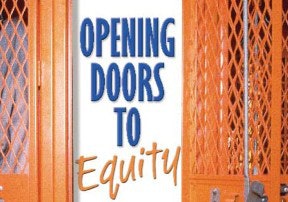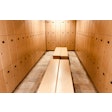School locker rooms built before the women's sports boom warrant reexamination and, quite likely, renovation to comply with Title IX standards.

The importance of locker room atmosphere to an athlete is undeniable. Aside from serving as space in which street clothes are exchanged for school colors, locker rooms are pregame launching pads, halftime think tanks and postgame places of solace and celebration.
Within the past decade, locker rooms have even served as a source of celebration for some, as high school girls and college women with locker room facilities inferior to those of their male counterparts have challenged the legality of such inequities and succeeded in evening the score. The locker room victories, often part of larger gender-equity battles waged on respective campuses, have rarely garnered much attention outside the circle of athletes most affected and the school administrators forced to right the wrong. And though inequitable locker rooms may not warrant the headlines devoted to Title IX complaints that target skewed participation numbers, compliance regarding the equitable treatment of student-athletes can be no less daunting for school officials.
"It's not easily done with locker rooms," says Donna Lopiano, executive director of the Women's Sports Foundation, an East Meadow, N.Y.-based advocacy group that monitors Title IX progress. "Locker rooms are probably the slowest-to-comply area because they're big money and because everybody's spent a lot of time on the participation issue, but very little attention is being paid to the laundry list of other benefits under Title IX."
Title IX language that deals specifically with equal opportunity in athletics combines "provision of locker rooms, practice and competitive facilities" as one of 10 items on that laundry list of compliance considerations facing school administrators. The Department of Education's Office for Civil Rights, which investigates Title IX complaints, interprets the locker room provision to encompass both "availability of locker rooms" and "quality of locker rooms." A high school with two locker rooms for boys and one for girls, for example, would be breaking the law. So would a school with two locker rooms for each gender, but with smaller locker rooms for girls. And factors such as locker room amenities, accommodations for coaches or proximity to playing fields may also be enough to tip the scales.
"At the high school level, what you often get are old schools built before the 1960s in which boys had large locker areas, team areas and coaches' lounges built, and then just a tiny physical education locker room for girls," says attorney Kristen Galles of Equity Legal, an Alexandria, Va.-based firm that litigates Title IX cases on behalf of coaches and athletes. "So you get thousands of high schools out there that didn't fix the problem when the world changed in the 1970s and girls started playing sports."
Yarmouth (Maine) High School fits that bill, but its current plan to renovate came not from an OCR complaint but rather as the result of an accreditation review by the New England Association of Schools and Colleges. In 1996, when renovation plans were first drawn up, Yarmouth administrators needed little convincing that their locker rooms, as designed some 40 years earlier, favor boys-both in square footage and frills. "It's a 1960s building, and it needs renovation," Yarmouth Principal Wendy Houlihan says. "In 1960, there was a little different approach to athletics, but we do want to have equitable facilities for male and female athletes. We have a very strong athletic program all around, and we'd like to bring our locker rooms into the modern era."
A stopgap renovation three years ago saw showers added to the girls' locker room and its lockers repainted, but the issue of square footage wasn't addressed. The current plan calls for the 1,650- square-foot girls' locker room and the 1,900-square-foot boys' locker room to each be expanded to 2,500 square feet. Both locker rooms will feature two coaches' offices and access to a shared corridor leading to new weight room and training facilities. To accommodate the locker room expansion, space will be captured from an adjacent cafeteria that currently includes a stage at one end. A new auditorium will ultimately accommodate the school's staging needs, and the cafeteria will be expanded in another direction, Houlihan says.
Compared to school officials, members of the Yarmouth town council, which must approve the plan before sending it to a referendum, have been a tough sell, particularly since the plan's overall price tag has soared to $14 million-$8 million more than original estimates. According to Houlihan, the project may be spread out in phases, and she remains confident that locker rooms will be renovated in the end. "They've got to be, as far as I'm concerned," she says.
While the sticker shock at Yarmouth High was caused by a wide-reaching renovation proposal that includes some non-athletics-related construction, reconfiguring interior spaces (including locker rooms) is typically a less expensive renovation alternative to expanding a school's footprint. "Financially, it's better to renovate interior space," says Gerald Hurley, a principal at Bay Architects in Houston who has compared boys' and girls' athletics facilities at several Texas high schools. "But can you steal space from adjacent programs? If you can't, there is no economy on the interior. You have to go outside."
The cost of locker room renovation will vary based on a number of factors, including region, Hurley adds, but one thing is certain: projects that involve the installation or rerouting of plumbing come at a premium price.
In that sense, the Clear Creek Independent School District in southeast Texas got lucky with its recent locker room renovation. A Title IX complaint filed against the district in April 1996 cited inequities between locker room facilities provided for boys' baseball and girls' softball on three high school campuses, but no walls needed to be knocked down or plumbing altered. "Square footage in locker rooms was not a problem. However, shortage of lockers was," says Kim Goertemiller, the district's athletic director at the time and the current assistant principal at Lake Travis High School in Austin. According to the complaint, each boy enjoyed exclusive use of his own locker, while girls were forced to share lockers.
Accompanied by Hurley, Goertemiller conducted a district-wide comparison of facilities by sport and ordered enough lockers to fill any discovered voids, including some areas in which girls' lockers outnumbered boys'. Some 450 full-size, vented athletic lockers were purchased (at about $100 per locker) and installed during the following budget year. As schools waited for their new lockers to arrive, interim usage policies mandated that boys double up to match the amount of sharing being done by girls, even though it left lockers in the boys' room empty and unused. "That kept us in compliance," Goertemiller says.
Though the Clear Creek complaint was resolved relatively easily and quickly (within six months), it involved some additional compliance issues to keep in mind. During on-site visits, OCR representatives emphasized that the district needed to have in place written policies regarding locker room usage and locker issuance. "They like it in writing, very clear, so coaches have to be held accountable to whatever is written as district policy," Goertemiller says. It was also apparent that booster club influence had gone unchecked, leading to certain inequities. "What really hurt us in the beginning is the baseball booster clubs raised much more money than the softball booster clubs. They had made several renovations and additions to the facilities. Softball was not able to raise as much money as baseball, and that caused a very visible inequity issue," Goertemiller says. "The OCR does not come in and deal with a booster club; it deals with a district. The district is ultimately responsible for all of its facilities. If your baseball booster club comes in and makes large donations that may cause inequity, the district has got to either say no to that or it has to work with the female program and make those additions as well."
The number of lockers issued to athletes and the amount of space devoted to locker rooms often provide tangible evidence of gender inequity. But the list of potential locker room powder kegs doesn't end there.
Equal accessibility to locker room amenities with the potential, if shared, to benefit both genders is essential, according to Galles. "Training has become more important in high school athletics, but a lot of these schools' training rooms are inside the boys' locker room," she says. "So renovating in a way that makes the training room accessible to boys and girls is another thing that often comes up." Coaches also can be subject to discrimination in high school locker areas, with a trickle-down impact on studentathletes, Galles adds. Coaches' offices and lounges are perks traditionally more common to those individuals with boys' locker room access, she says. "You have several coaches' offices all sort of surrounding a living-room area with a TV and a couch. Well, what does it mean if your coaches' lounge area is part of the boys' locker room? You don't hire women as coaches, because you don't have anyplace to put them. So you end up having all male coaches, and then the girls don't have role models."
Team rooms-areas reserved for exclusive use by one team during a season or, in the case of some football programs, year-round-may be regarded as a rite of passage by some and an inequitable luxury by others. Galles is currently involved in a case in which a Connecticut high school offers its male students a physical education locker area that includes two team rooms-one for varsity teams and one for junior varsity teams-while the girls have access to a PE area with no team rooms. In this case, the solution appears obvious. "What are you doing with boys' junior varsity having a team room and girls' varsity not having a team room?" Galles asks. "You can reallocate the existing space so that only varsity athletes have a team room - one for girls, one for boys."
An even more extreme example of inequity comes from the Division II college ranks and New Mexico Highlands University. According to Galles, who litigated a federal lawsuit against NMHU on behalf of four female student-athletes and three women's coaches last December, the school's athletic department pours money into its football program at the expense of women's athletics. The football team enjoys use of its own building - a so-called football field house adjacent to the team's stadium. Located within the field house are a football locker room, team rooms, coaches' offices, big-screen TV viewing areas, a training area and a sauna. By comparison, women's athletic programs at NMHU are housed in a separate physical education building, where one locker room is shared by as many as four teams, depending on the season.
The ultimate insult proved to be the athletic department's policy of promoting its football program by allowing local high school teams to play at its stadium. Instead of opening the posh football locker room to their prep guests, NMHU athletics officials assigned them to a locker area used by the women's volleyball team. "It was a real slap in the face to be a 22-year-old college senior and some 16-year-old is kicking you out of your own locker room," says Galles. The jury awarded undisclosed monetary damages to the athletes (two volleyball players, a softball player and a soccer player) and coaches (who had been terminated after complaining about the inequities). But unlike a successful OCR complaint, which at least carries the threat of withholding federal funds to help spur change, the lawsuit's successful outcome in no way obligates NMHU to address its locker room inequities. Only the judge can order the school to act, and a year later, Galles is still seeking injunctive relief.
Some victories come easier than others, but gender-equity experts agree that any situation can be remedied. "There are answers to these problems if schools want the answer," says Lopiano. "In general, progress is being made when there are new facilities involved, but it's really slow going in terms of retrofitting the old ones." One would think that today's architects have learned from the locker room design mistakes of the past, but Galles isn't so sure. Within the past two years, she was presented with a school district's plans for a new field house-one that included exclusive locker space for football, as well as another separate team room within the boys' locker area. Meanwhile, the plan allocated one nofrills locker room for girls. "We're talking late-1990s, and the architectural firm had not even thought about putting a coaches' office in the girls' locker room," Galles says. "Somebody who is designing schools in 1999 ought to know more about Title IX.
"Architects know what the Americans with Disabilities Act requires, but they may not think about Title IX, because, frankly, Title IX only comes up in schools. So someone who designs buildings isn't necessarily going to think about making things gender equitable, but when you design schools or educational facilities, you have to do that." As an architect who has done his gender-equity homework, Hurley agrees. "Anybody who is doing those kinds of projects on a regular basis should certainly be familiar with Title IX," he says, adding that facilities built today nearly always exhibit gender equity. "If they don't, the architects didn't do their job."





































